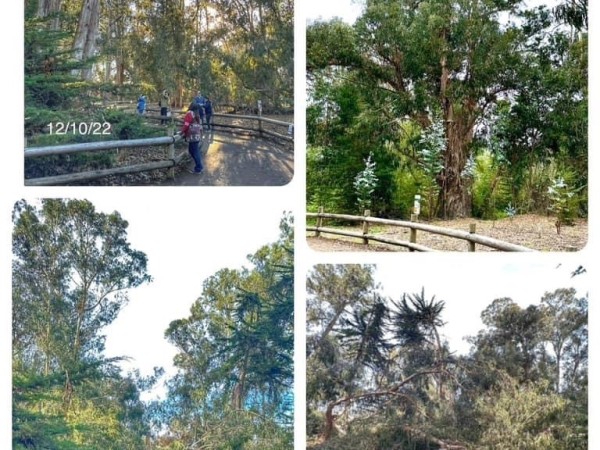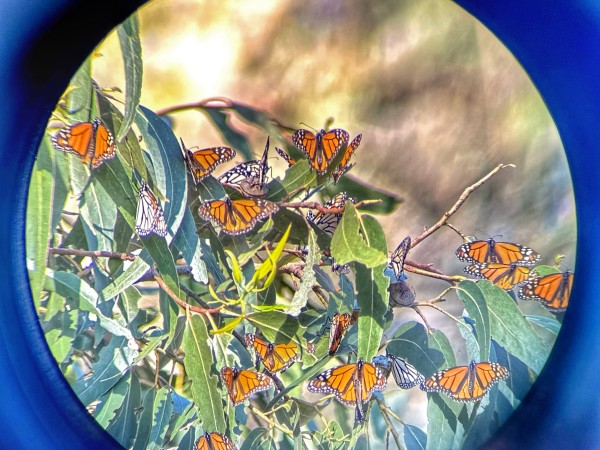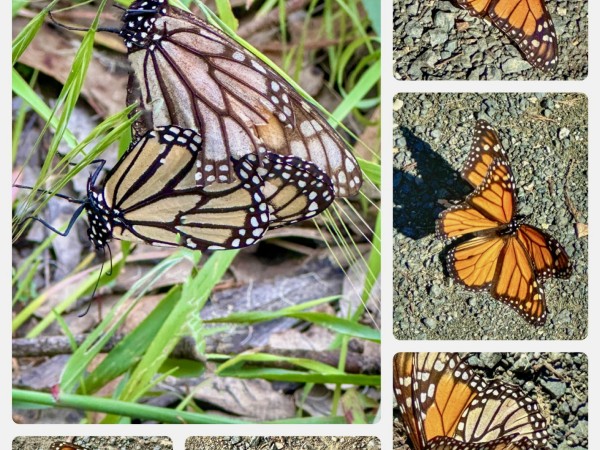Letter From Gail Morris: Western Monarch Spring 2023 Report#1
Spring is in the air!
Western Monarchs Update
Spring is in the air and monarchs are mating and more active along the California coastal overwintering sites. Yet many are still nestled in the safety of the groves due to the cooler weather earlier, extending their stay. Rather than clustering, monarchs are now more spread out in the trees. Waiting longer in the groves is good for the monarchs, giving early emerging milkweeds more time to appear and grow waiting for gravid females.
Pismo Beach Overwintering Site
Winter storms ravaged the California coast including monarch overwintering sites this season. Pismo Beach Monarch Grove withstood many Pacific wind assaults but several trees finally succumbed to the fierce winds in February. Marylou Barker Gooden reports, “This season’s favorite tree for the monarchs came crashing down on 2/1/23 resulting in lots of blue sky and open space. Fortunately, the 10,817 monarchs (counted on 1/17/23) had moved to the trees along Hwy 1 last week in response to storms.”
Despite the tree loss, monarchs continued to fare well. Movement between groves is common this time of year. Marylou noted, “As of 2/7/23 Pismo has 15,015 monarchs despite the loss of trees and the storms.” Saturday, Marylou noticed much more monarch activity in the grove. “With the warmer weather, the monarchs spend their days mating and spread throughout the grove instead of clustering. Our visitors are enthusiastic, including three from Chicago who dressed up for the occasion.” Everyone is wondering, how long will the monarchs stay before leaving on their spring migration?
Official Thanksgiving Count Announced
The Xerces Society released the 2022 Western Thanksgiving Count of monarch butterflies recently. The final count during the study’s Thanksgiving official tally period is 335,479 butterflies, an increase from last year. Read more details>>
Western Monarch Summit
Just under 200 people attended the Western Monarch Summit hosted by the Western Monarch Advocates in San Luis Obispo on January 20-22, 2023. Over 25 speakers shared timely topics on monarch biology and conservation. The Summit featured speakers from Monarchs of the Pacific Northwest, Southwest Monarch Study, Xerces, WAFWA, Monarch Watch, several California RCDs, and many more. Saturday evening revolved around a “Networking Night Through Community Science Engagement” with 23 tables of on-the-ground community science projects for everyone to learn more about and sign up. Five organizations also participated in a poster session. The Summit concluded with a Panel Discussion featuring monarch “Monarch Challenges in the West” with topics drawn from questions submitted by participants during the conference. A fun time was had by all!
Thank You!
A special Thank You to Marylou Barker Goodan and Betty Sleeth for their reports and photos.
Send in your reports!
Look and photograph (if you can) barely emerging milkweeds and monarchs of any life stage (eggs, larvae or more!) Report to Journey North—Provide as much information as you can such as weather conditions (it’s okay to estimate). Your detailed description of what you see can include, but is not limited to, the monarch’s gender and activity and, if known, the type of milkweed, and flowers if they are nectaring. Let us know how monarchs are faring under stressors from winter storms still sweeping through!
Gail Morris is the Coordinator of the Southwest Monarch Study (www.swmonarchs.org), a Monarch Watch Conservation Specialist, and the Vice President of the Monarch Butterfly Fund, the Central Arizona Butterfly Association, and the Western Monarch Advocates. The Western Monarch Population News is based on comments provided to Gail Morris. We hope to increase the number of sightings and therefore photos and comments entered into the Journey North. We rely on the volunteers who communicate regularly with Gail and who agree to participate in our effort to increase awareness of the population of western Monarchs. You can reach her at gail@swmonarchs.org
Submitted, 02/13/2023; published 02/14/2023



